Ever wondered what the difference is between Machine Learning vs AI? You’re not alone. We’re here to clear things up in a fun way.
While they might seem the same, they are two distinct ideas that work together in cool and surprising ways. Why does this matter? Well, AI and ML are already everywhere, like in your phone’s voice assistant, the movies recommended on your streaming app, and even in self-driving cars.
Knowing the difference between AI and ML can help us better understand how these technologies change our world. AI and ML are shaping the future from smart gadgets to self-driving cars.
In this article, we’ll discuss machine learning vs AI in simple, fun terms so you can say, at the end, ‘Ah, I get it now!’
Get, Set, Learn.
What is Machine Learning (ML)?

Machine learning is a type of Artificial Intelligence where computers learn from data without needing humans to tell them exactly what to do. It’s like giving a computer the ability to understand and improve by looking at information.
Types of Machine Learning
Here are some types of machine learning: 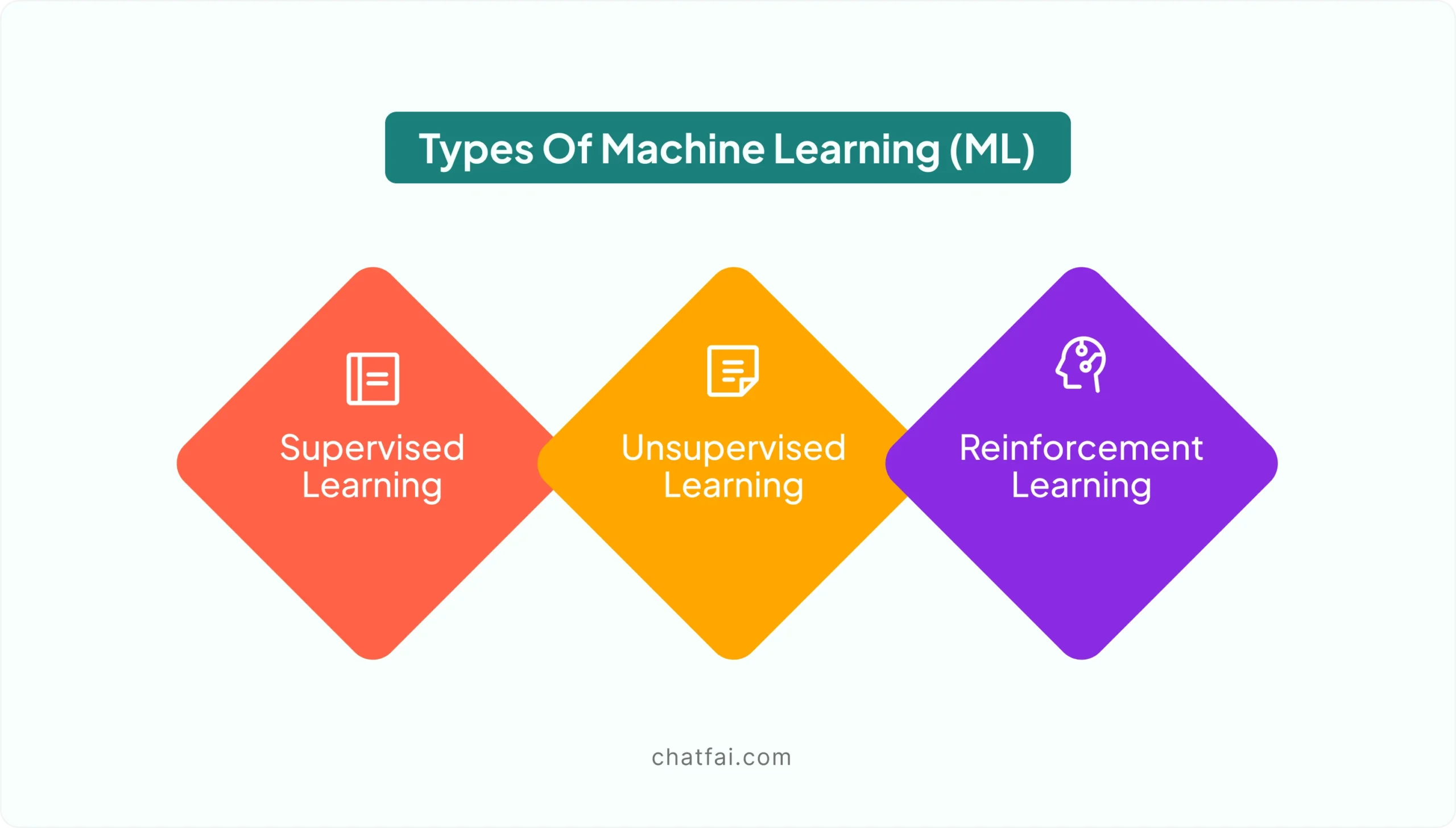
Supervised Learning is like teaching a computer using examples, like how you might teach a child. In ML, you provide the computer-labeled data (like showing pictures of dogs and telling it, “This is a dog”).
The computer learns by seeing examples and figuring out how to recognize things independently.
In this case, there is no teacher. The computer examines a lot of data to find patterns and connections. It’s like a detective trying to figure out what’s important without anyone giving clues.
This type of machine learning tries different actions, gets feedback, and improves over time. It learns from its mistakes and successes.
In short, Machine Learning helps computers improve at tasks independently by learning from data, whether with examples, patterns, or feedback.
Want to learn more about the advantages of machine learning? Here’s a guide for you!
What is Artificial Intelligence (AI)?
So, what exactly is Artificial Intelligence (AI)?

Think of AI as a brain for machines, helping them do things that generally need human thinking. It’s like teaching a computer to think and decide independently without being told every little thing. From understanding speech to playing chess, AI is about getting machines to do smart tasks that usually require a human brain.
Are you curious about the latest advancements in AI? Check out AI tool trends to see how this technology is changing the way we live and work!
Types of AI
AI can come in different shapes and sizes.
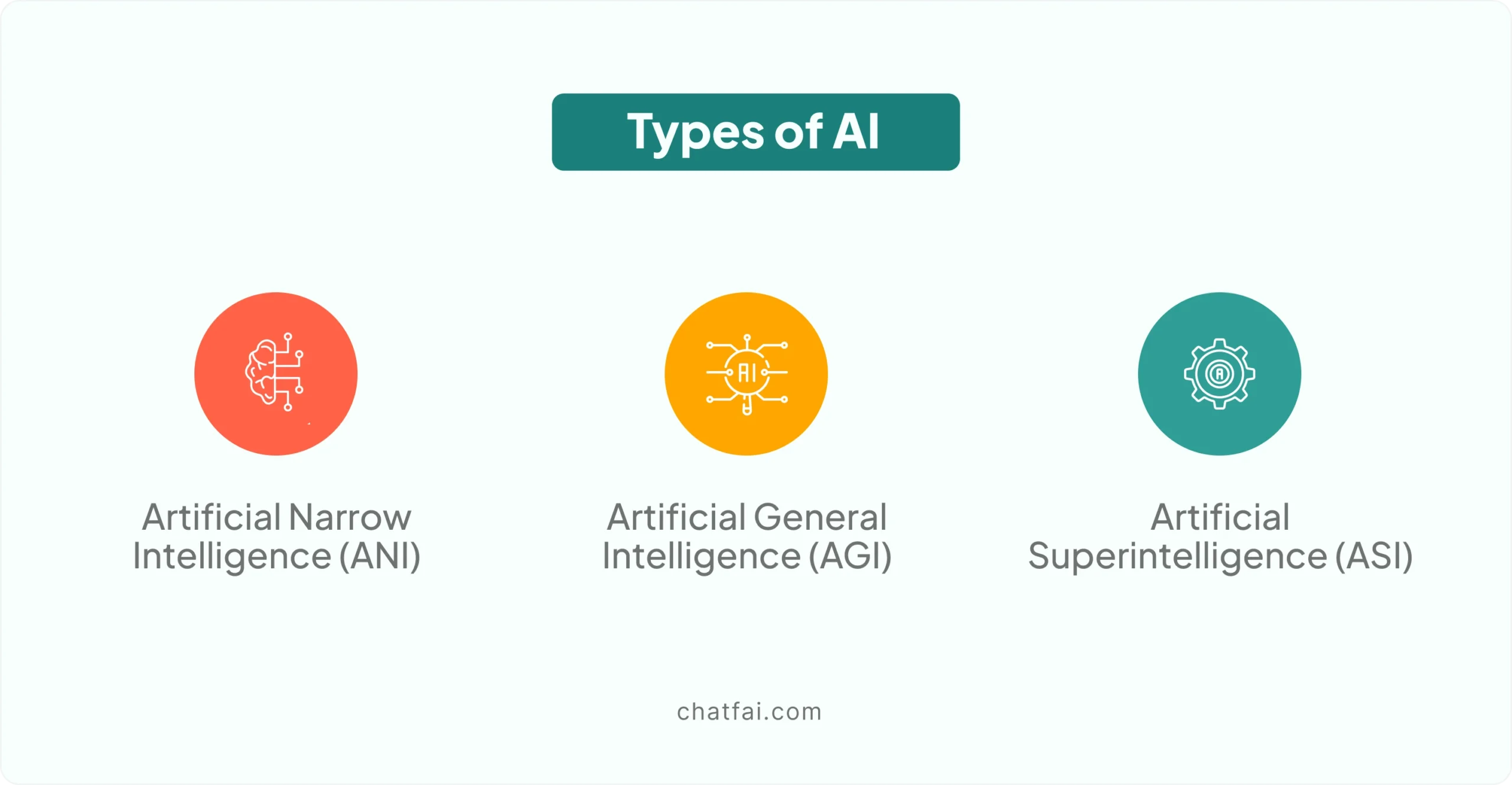
There are three main types of AI, and each does something a little different:
-
Artificial Narrow Intelligence (ANI)
This is the most common form of AI today. It’s good at one specific thing, like playing chess or recommending songs on Spotify, but it can’t do anything else.
-
Artificial General Intelligence (AGI)
This is the dream AI that can do anything a human can do. AGI is a robot that can learn, reason, and solve problems like you do.
-
Artificial Superintelligence (ASI)
This is the next level. It’s when AI becomes way more innovative than humans and can solve complex problems faster than we ever could. We’re still far from this stage, but who knows? It could be the future.
Want to see how AI is shaking up entertainment? Check out how AI in entertainment is changing how we create and enjoy movies, games, and music.
Let’s get straight to our topic, Machine Learning vs. AI: How they differ, and learn something new.
Machine Learning vs AI
So, AI is the big boss in the overall idea of creating smart machines that can think, solve problems, and make decisions. Machine learning is one of the coolest ways we can make that happen.
While AI is the entire field, machine learning is the secret sauce that helps computers learn from data and get smarter.

AI = The brain.
ML = The training that makes it smart.
Benefits & Limitations Machine Learning vs AI
Both have benefits and limitations, and the right choice depends on what you need to do.
| Benefits of ML |
Benefits of AI |
| Learns from data |
Can do many tasks |
| Improves over time with more data. |
Makes decisions on Its own |
| Works in many areas |
Adapts to new things |
| Works with big data |
Saves time |
| Automates tasks |
Wide scope of applications |
Limitations of Machine Learning vs AI
| Limitations of Machine Learning |
Limitations of AI |
| Can be biased |
It needs a lot of power |
| Hard to understand |
Doesn’t truly understand things |
| Needs accurate data |
It can be hard to explain |
| It needs a massive amount of data |
Needs constant updates |
| Can overfit |
Ethical concerns |
Applications of ML and AI
AI and ML are potent technologies used in many parts of our daily lives.
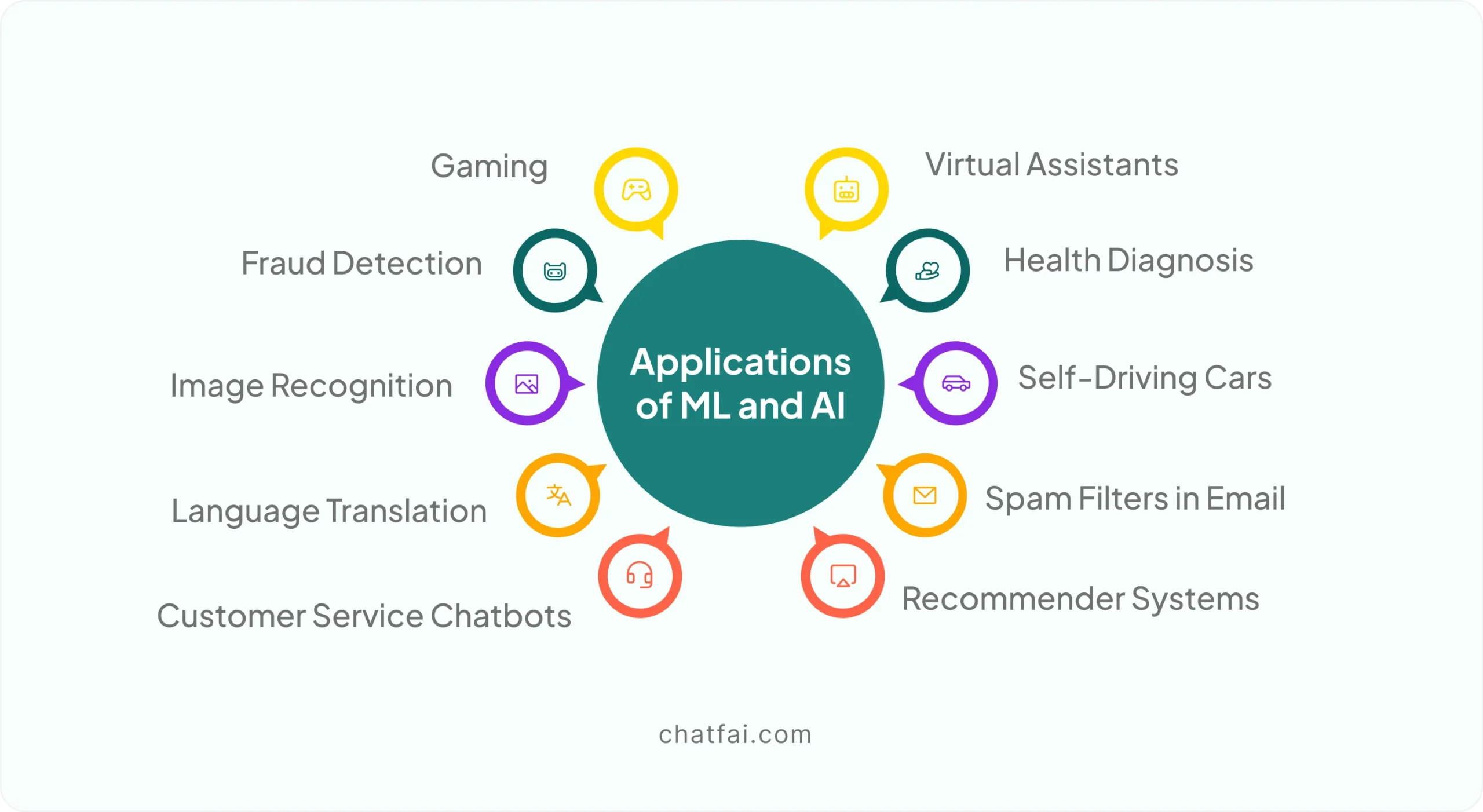
Here are some simple ways they are applied:
1. Smartphones and Virtual Assistants

Siri, Google Assistant, or Alexa use AI to understand your voice, answer questions, set reminders, and help with tasks.
2. Recommender Systems

Netflix, YouTube, or Amazon looks at what you’ve watched or purchased before and suggests new movies, shows, or products you might like. This is happening through AI.
3. Self-Driving Cars

Tesla, Waymo (Google’s self-driving car), AI, and ML help cars see and understand the road, recognize traffic signals, avoid obstacles, and make driving decisions without a human.
4. Spam Filters in Email

Gmail’s spam filter, machine learning models learn to recognize which emails are junk or spam based on past examples and filter them out automatically.
5. Health Diagnosis
Machine Learning can help doctors by examining medical pictures (like X-rays or MRIs) and identifying signs of illness. It helps doctors find problems faster and more accurately.
AI therapy can also help doctors by giving personalized treatment plans and offering mental health support, improving patient care.
6. Fraud Detection

Machine Learning can detect when something strange happens to money or accounts, helping to keep people’s money safe.
7. Customer Service Chatbots
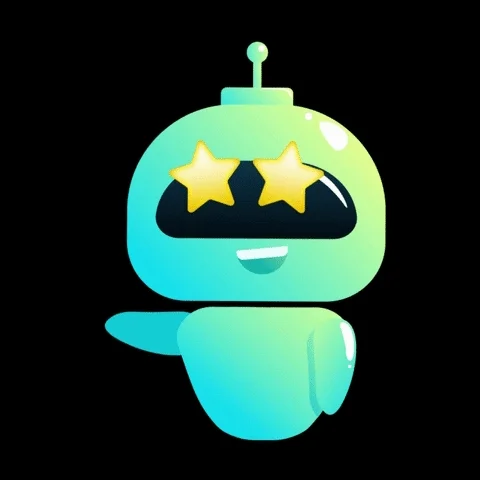
AI chatbots are like digital helpers. They can talk to you, answer your questions, solve problems, or even help you shop online.
8. Image Recognition
AI can look at pictures (like on social media) and determine what’s in them.
For example, it can identify people’s faces or objects and even help automatically tag your friends in photos or organize pictures based on what’s in them.
AI can also create new images based on your descriptions with an AI image generator, visually bringing your ideas to life.
9. Language Translation
AI uses large amounts of text in different languages to help translate one language into another.
AI language learning apps help you practice and improve your skills in different languages at your own pace.
10. Gaming

AI in video games controls non-player characters (NPCs) and opponents, making them act more innovative and more realistic.
In short, AI and ML help computers and machines learn from data and make decisions or predictions, making life more efficient and fun.
AI also helps create unique video game characters, giving them personalities and behaviors that adapt to your actions, making gameplay fun.
Examples: Machine Learning vs AI in Action
To understand how Machine Learning vs AI works in practice, let’s take a look at some real-world examples that illustrate how each is used:
Machine Learning in Action
1. Recommendation Systems (Netflix, YouTube, Amazon)
When you watch a movie or buy something online, the system tries to guess what you might like next. It looks at what you’ve chosen before and suggests other movies, videos, or products you might enjoy. Nice, right?

It’s like having a friend who always knows what to recommend based on what you liked in the past.
2. Speech Recognition (Siri, Alexa, Google Assistant)
You talk to your phone, and it actually understands you. Siri knows what you’re saying, and Alexa plays your favorite song with a voice command.
3. Face Recognition (Face ID, Google Photos)
When you unlock your phone or tag photos, machine learning helps it recognize your face or the people in your pictures. Pretty cool, right?

AI in Action
AI isn’t just a sci-fi dream. It’s already in your life. Here are three ways AI is making things easier or more relaxed every day:
1. Voice Assistants (like Siri or Alexa)
You talk to your phone, and it talks back. You ask it to play music, tell the weather, or set an alarm. This is AI listening to your voice, understanding what you’re asking, and doing it.
2. Netflix and YouTube Recommendations
Have you ever noticed how Netflix suggests you might like or how YouTube knows what video to recommend next?
That’s AI in action!
It looks at what you watch and learns your preferences.
3. Self-Driving Cars
Imagine sitting in a car that drives itself. AI makes this possible! It helps the car understand what’s around it, like the road, other cars, and obstacles, and makes decisions to drive you to your destination safely.
Which AI Is Better for Different Use Cases?
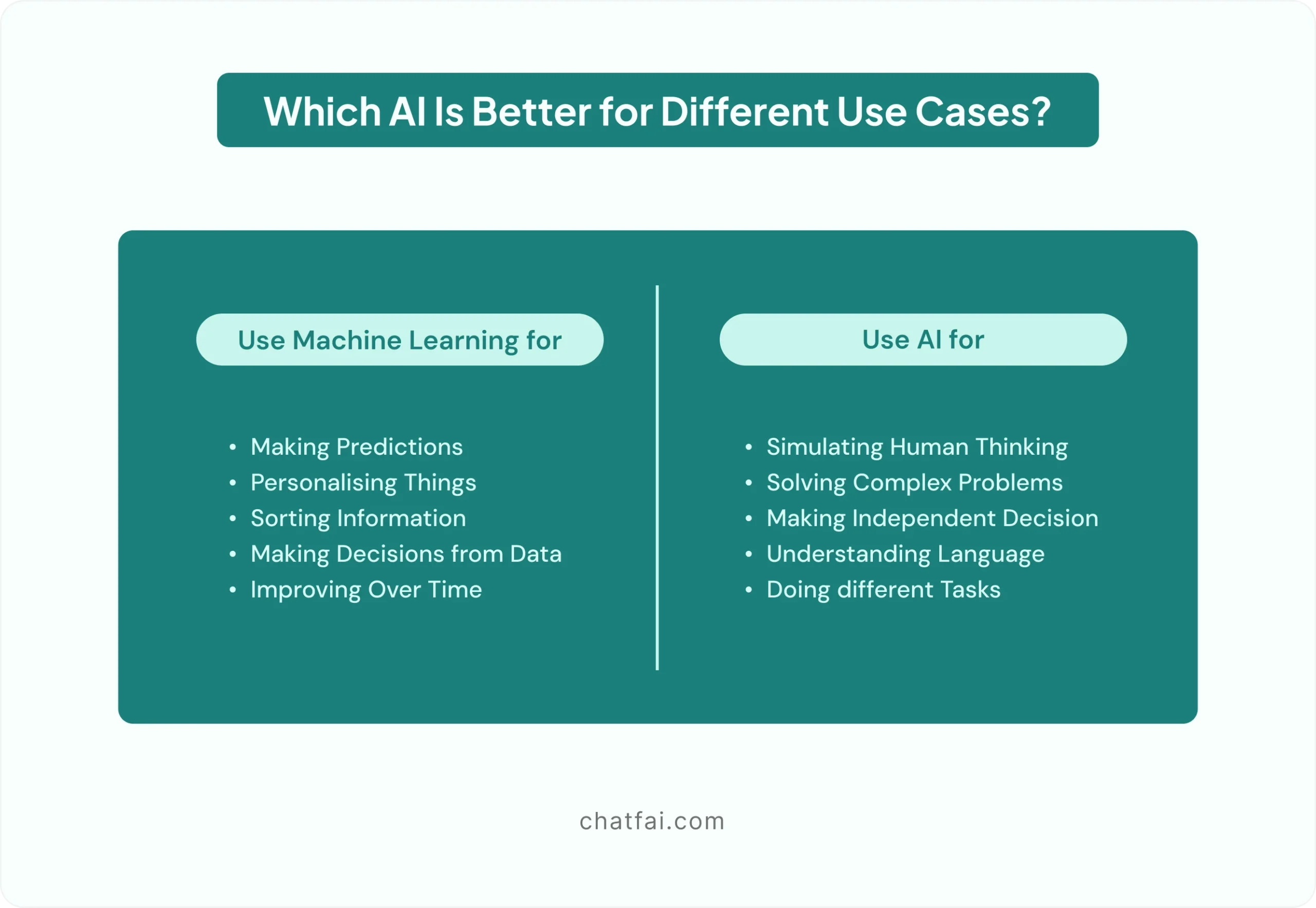
AI = The brain.
ML = The training that makes it smart.
Conclusion
So there you have it: machine learning vs AI.
AI is like the “brain” that helps machines think and make decisions, while Machine Learning (ML) is the way we teach them to get smarter. Think of AI as the big goal of creating machines that think like people. ML is the tool we use to help these machines learn from data and improve their work.
Isn’t technology remarkable when it can learn just like us?
Whether it’s recommending your next binge-watch or teaching self-driving cars how to navigate the road, AI and ML are already making our lives easier. So, the next time you hear about ML or AI, you’ll know the difference and how they work together to shape the future.
Cool, right?

Want to learn more about AI and ML? Explore and see how these mind-blowing technologies are changing the world, one innovative machine at a time.
Drop your questions below or share this with a friend who’s curious about AI and ML.

FAQs
Q: Is machine learning and AI the same?
No, AI is a broader field that includes many techniques, while ML is a part of AI that focuses on teaching computers to learn from data.
Q: Which is better, AI or ML?
It’s not about one being better. ML is a technique used to create AI systems, so both are important in their own way.
Q: Is ChatGPT AI or ML?
ChatGPT is based on both AI and ML. It uses machine learning models to understand and generate text, a form of AI.
Q: What is AI but not ML?
AI includes things like expert systems, which do not involve machine learning. For example, a chess-playing program using fixed rules is AI, not ML.
Q: Should I study machine learning or AI?
If you like working with data and making computers learn from it, study ML. If you’re interested in building intelligent systems in a broader sense, study AI.
Q: Is Alexa AI or machine learning?
Alexa uses both AI and ML. It uses machine learning to improve how it understands speech and responds, which is a part of its AI.
Q: Will AI replace ML?
No, ML is a vital part of AI. ML helps AI systems learn from data, so they work together.
Q: Who earns more, AI or ML engineer?
Both roles are highly paid, but typically, ML engineers earn slightly more because of the high demand for their specialized skills.
Q: Which is first, AI or ML?
AI came first. Machine learning is a subfield of AI that became popular later on.
Q: Can AI replace machine learning?
No, machine learning is a technique within AI. AI can’t replace ML because ML is essential for many AI systems.
Q: Is AI art AI or machine learning?
AI art is mainly made using machine learning models, so it’s both AI and ML.
Q: What are the basics of AI and ML?
AI is about making machines smart, like humans.
ML is a way to teach machines to learn from data without being programmed for every task.
Q: Is machine learning vs AI vs data science?
Machine learning is a part of AI that focuses on learning from data.
AI is about creating intelligent systems.
Data Science is about analyzing and interpreting data to gain insights, and it often uses AI and ML tools.